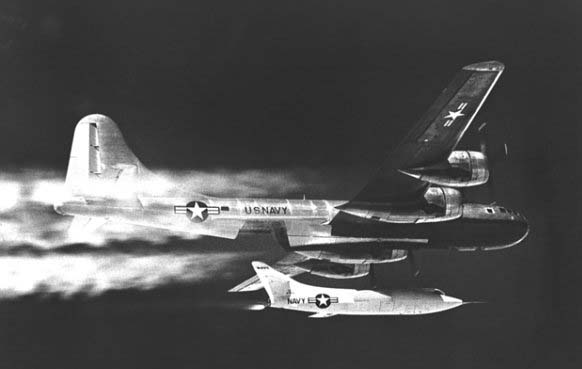
Fifty-six years ago this month, the USN/Douglas D-558-II Skyrocket became the first aircraft to fly at twice the speed of sound. This historic event took place on Friday, 20 November 1953 at Edwards Air Force Base, California.
The D-558-II was a United States Navy (USN) X-aircraft and first flew in February of 1948. It was contemporaneous with the USAF/Bell XS-1. The aircraft measured 42 feet in length with a wing span of 25 feet. Maximum take-off weight was 15,266 pounds. Douglas manufactured a trio of D-558-II aircraft (Bureau No.’s 37973, 37974 and 37975).
The original version of the swept-wing D-558-II had both rocket and turbojet propulsion. The latter system providing a ground take-off capability. However, like other early X-aircraft such as the XS-1, X-1A, X-2 and X-15), the D-558-II achieved max performance through the use of a mothership and rocket power alone.
On that record-setting day in November 1953, the D-558-II (Bureau No. 37974) was carried to the drop altitude of 32,000 feet by a USN P2B-1S (Bureau No. 84029). NACA test pilot A. Scott Crossfield was in the D-558-II cockpit. Although ailing with the flu, Crossfield was not about to let a little urpiness force him to miss today’s events!
Following drop, Crossfield ignited the Reaction Motors LR8-RM-6 (USN designation for the XLR-11) rocket motor and started uphill. After closely adhering to a carefully planned climb schedule, Crossfield initiated a pushover at 72,000 feet that resulted in a shallow dive. Passing through 62,000 feet, the D-558-II hit 1,291 mph; Mach 2.005.
The D-558-II reached Mach 2 due to a confluence of several factors. First, Crossfield flew the profile as briefed. Second, temperatures at altitude that day were unusually low. This lowered the speed of sound and thus increased Mach number. Third, the ground crew did an extraordinary job of optimizing the D-558-II for the max speed mission.
Expanding on the last point mentioned above, extension tubes were added to the LR8-RM-6 rocket motor. This increased thrust from 6,000 to 9,000 pounds. The aircraft was then cold-soaked overnight in an effort to maximize its propellant load. Finally, external airframe gaps and panel openings were taped over and the aircraft was waxed and polished in an effort to minimize aerodynamic drag.
Scott Crossfield received the 1954 Lawrence B. Sperry Award for his Mach 2 exploits. The record-setting aircraft (Bureau No. 37934) is currently displayed at the National Air and Space Museum in Washington, D.C. in tribute to its many contributions to aviation history.

